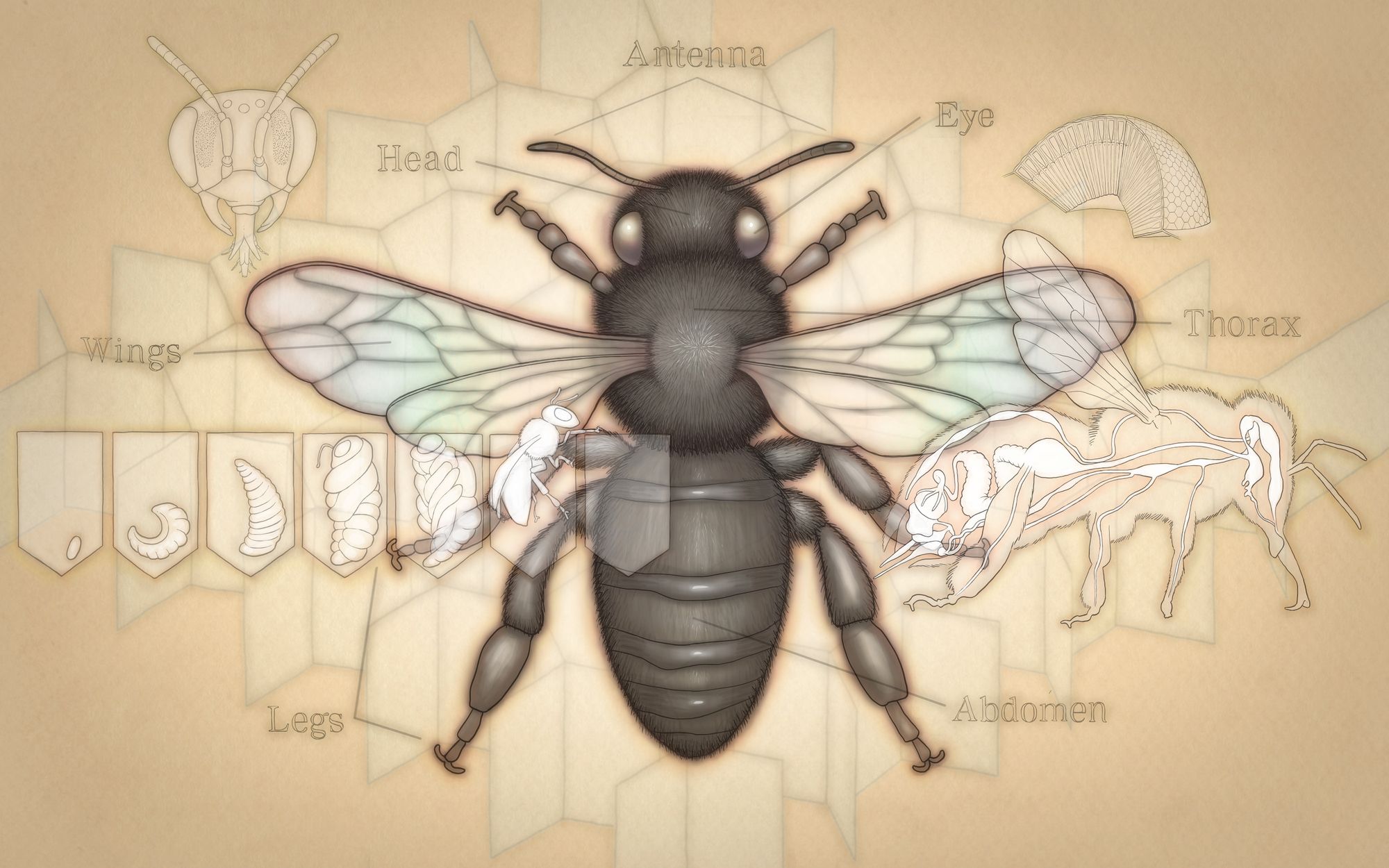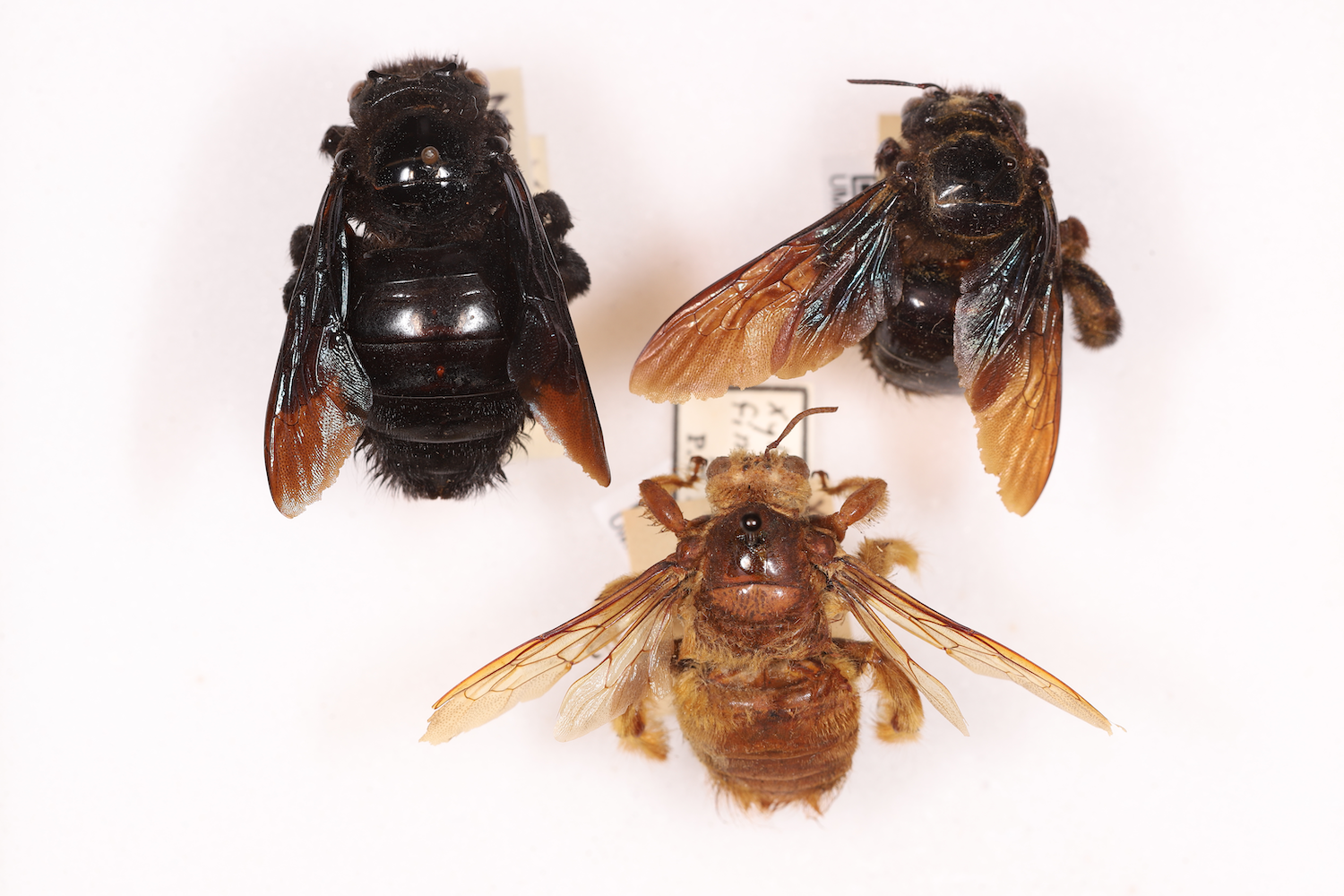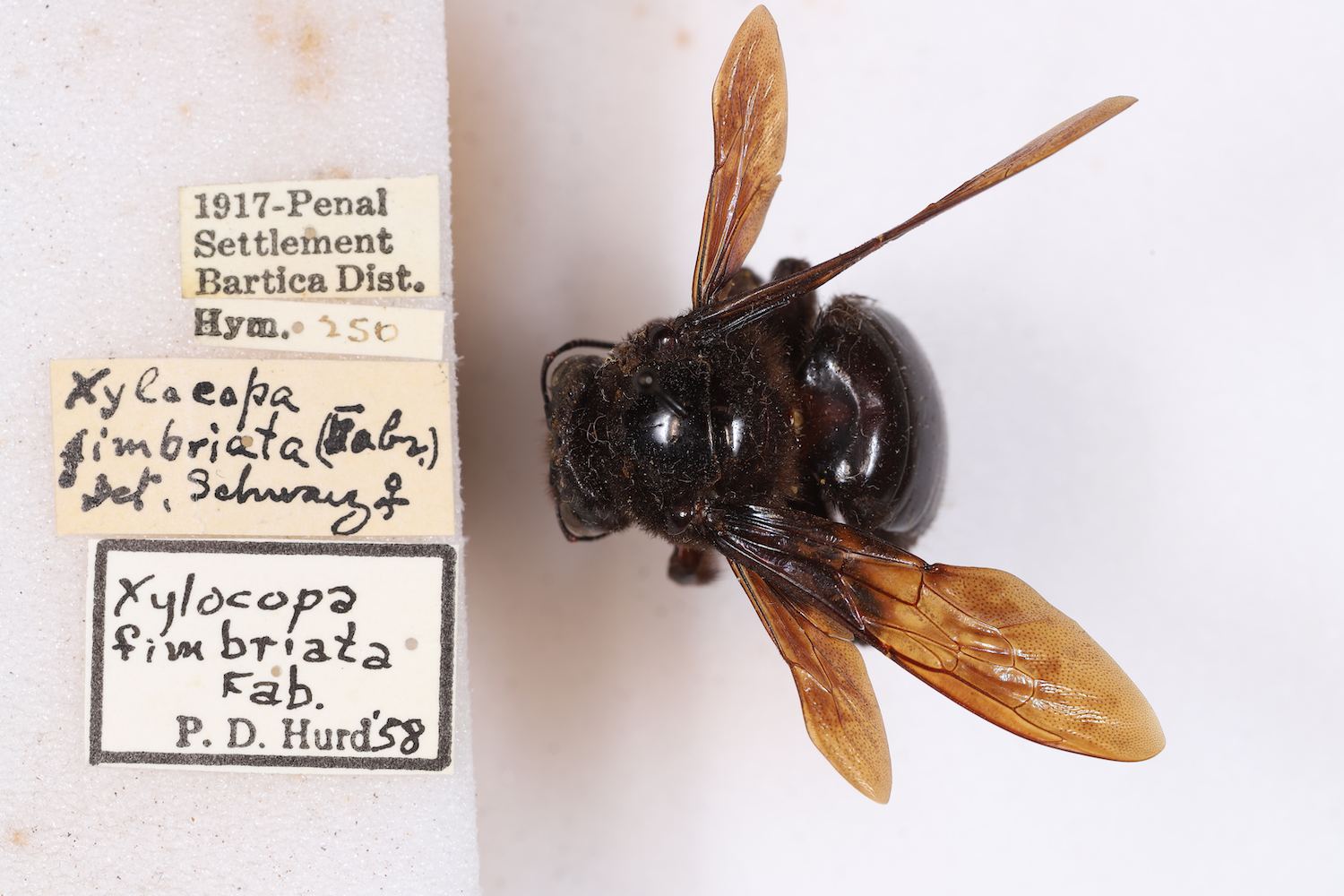
The Three-Century Lifespan of the Modern Bee
The preservation of individual bee specimens across the centuries allows us to embrace the temporal expanse of what came before us, and leave good records for those who follow.
LEARN MORE
Two London men explore an assembly of log cabins beneath the South American sun, armed to the teeth with nets and pins. It is the summer of 01845 in the heart of “British Guiana” — a colonized name and government that no longer exists, though the land remains and will remain until all names for it have been forgotten — and the air is alive with the smell of flowers and the hum of insects. For two centuries, Europeans have pillaged this land for all manner of riches: sugarcane and tobacco, coffee and cotton, raised on plantations and tended by the dispossessed indigenous populations and enslaved peoples brought here from Africa.
These two men have also come to take something, though they do so in the name of Western science. Emissaries of the burgeoning discipline of entomology, they stalk the highlands for the huge, black bees whose iridescent wings shimmer like panes of rainbow glass in the tropical sunlight.
Each specimen is gathered, mounted, and labeled with the utmost care. Handwritten tags with the date and locality are added: one man misspells a nearby indigenous landmark, while the other indicates that the pair are just a mile southeast of the larger settlement of Packertown. (Today, in 02023, there are no surviving historical records of this place.) Then, they add their own, unique data. On the back of a pamphlet detailing upcoming passenger ships to the ports, the younger entomologist records the behavior he observes. Almost like a haiku, he writes:
“In barn
at dusk, flying
noisily”
On another, he indicates, “Plucked from cotton, alive, but weak”, and on the third, “hoovering [sic] near roofing boards”. Almost every bee has a unique note, scribbled on a torn corner of a schedule, a newspaper, or the back of the date tag. In two hundred years, we will look back on these records as some of the earliest attempts at insect ethology — the study of behavior — which tell us more about the world and perspective of the entomologists of the 01800s than about the bees they captured.
His companion is equally rigorous, but in a different way. Rather than recording behavior, he scrawls as much minute detail as possible into his tiny scrap, until every bee has a label that reads something similar to “On porterweed flower about 2 meter high on the bank of a creek about 2½ km. southeast of Packertown.” (Typewriters have not yet emerged into common use, but sometime in the early 01900s a student of his student will retype these notes on more durable cardstock.) Four decades from now, detailed accounts such as these will help scientists describe the unique relationship between plants and animals: pollination, the process by which seventy-five percent of flowering plants on the planet reproduce and proliferate. It will finally be understood that insects — treated solely as pests and pestilence-bearers for centuries — are paramount to keeping the world green.
These two will continue their research for several months before returning to London. The jewel of their collection is known to them as Xylocopa cajennae, a huge and magnificent species that will accumulate many other names across the centuries. But the bee itself remains unchanged. It sits, pinned and labeled, in a climate-controlled box, tiny flecks of golden pollen still stuck in the hairs of its abdomen from its morning forage in 01845.
Specimens like these are ghosts of time and space. They — and the people who collected them — have been dead for long over a century. They are suspended in timelessness, and yet not so different from their seventieth-generation descendents: if you watched the iridescent-winged black bees of Guyana today, you would see them alight upon the flowers of porterweed plants, two and a half kilometers southeast of where a busy settlement called Packertown once stood. Even as we fade, we can be assured that the insects will remain, flying noisily at dusk.
In a cluttered study in Maryland of the 01950s, a pair of entomologists — partners in marriage for twenty years, and partners in the field for twenty-five — keep their growing collection of pollinating insects. Many specimens are from their own time together during expeditions across North America, traveling almost nonstop throughout the summer months and filling case upon case with bees from the Appalachian highlands down to the tropical Mexican grassland. The rest of the insects — filling jumbled boxes and cabinets and spilling over the furniture — are inherited from relatives or gifts from colleagues. Their private collection rivals most academic institutions of the time, and spans centuries of entomological field research.
But while it may appear that these specimens are scattered mindlessly about the room, there is a method to this messiness; in their older years, they have started to collect less, and identify more. Together, they sort every bee in their collection, and add a new label to its pin: a determination label, stating the genus and species it belongs to, as well as the year of their decision. Some of these specimens already have tags from the 01920s, and many will receive new ones at the turn of the next century, when the children of this entomologist pair donate their inherited collection to a research institution and the boxes are reopened for the first time in decades.

For now, however, these two are at the forefront of their field: insect taxonomy. Like all biologists, they use the Linnaean binomial system of species identification, but unlike Linnaeus, the entomologists of the 01950s have begun to realize that insects cannot be easily categorized by visual similarities alone. Nature journals are flooded with papers that consolidate two former “species” (typically the larger, solid-colored female and smaller, striped male) under the same name, split classifications apart to make room for new organisms to be described, or propose to discontinue a “synonym” — a redundant name for a species that has already been cataloged in Western scientific tradition. The backbone of this boom in taxonomy are collections such as this private Maryland cache, which allow comparison of dozens of individuals from countless insect species across the world. For the first time in history, entomologists can see the staggering, global diversity of insects laid out before their very eyes.
Among this couple’s most important specimens is a bee dated to 01845, labeled Xylocopa cajennae at the time of its collection, from a town they do not recognize in what is still known to them as British Guiana. They set it aside, and, gradually, other black-bodied bees with identical iridescent wings join it in its box. These have their own determination labels dating back several decades, reading: Xylocopa corniger, Megaxylocopa cornuta, Xylocopa fimbriata, and Xylocopa virescens. The entomologists study these specimens carefully. Though some are over a hundred years old, gentle treatment of these insects has kept their body segments, wings, and legs intact and comparable to contemporary individuals. Finally, after analyzing the location data recorded on their tags and the similarities of their morphology, the couple declares the collection to be of the same species. The oldest name — Xylocopa fimbriata — is given precedence; the rest are considered obsolete. In the spring, they publish their findings, alongside a proposition for a new species of American bumblebee: Terrestribombus magnus (by the year of 02014, this will be one of thirteen synonyms for Bombus cryptarum, a species first described in 01775.)
This married pair will publish together dozens of times more during their careers, and their students — women included, despite the hostility of the times — will continue their legacy of naming and renaming their collection, and when it passes into the ownership of a university, the cycle will continue. Science, like all knowledge, is mutable; our understanding of the world(s), ourselves, and the past and the future change every day. Specimens with multiple determination labels prove that our understanding of these creatures is a constant work in progress, evolving with our own ability to study them in increasingly detailed ways through global collaboration and collections, microscopic photography, genetic analysis. It is, in some ways, a representation of thousands of years of human history and curiosity, of the urge to collect and name all the things in the world. The preservation of individual specimens across the centuries allows us to share in that joy of discovery with those who precede us, and those who follow in our footsteps, fixing our names and perhaps creating some new ones of their own.
Technology makes things easier in 02023.
Our lab has a logbook by the door, with names dating back to the 01960s of visitors and their intentions (the research labs itself are far older than that, beginning in 01817 with the founding of the college.) Having one of the largest zoological collections in the world, international experts once traveled from across the globe to study and collaborate under our roof. Nowadays, if a Swiss ichthyologist wants to know the stomach contents of deep-sea fish from the University’s latest expedition, we can send them detailed lists and photos with the click of a button — no eight-hour flights required.


Photographs courtesy of the author, specimens courtesy of the University of Michigan Entomology Collections
But still, this global collaboration is dependent on the preservation of our physical specimens, kept safe in boxes and cabinets and gathered together from across the continents and centuries. My work involves the digitization of these individuals, photographing them and transferring the jumbled, fading information from their tags into our online database. I have held in my hands the Xylocopa fimbriata that those London men collected in Guyana, pollen clinging to its hindlegs, the overhead lights reflecting from its shiny, black carapace. In the 01800s, this specimen — and the thousands of others in our collection — helped biologists unravel the mysteries of pollination. In the 01900s, entomologists recorded their names in our logbook as they visited from faraway colleges of their own, using those same insects to expand our understanding of taxonomy, phylogeny, and the natural world; the Xylocopa fimbriata still bears the mark of this surge in taxonomic interest, with multiple determination labels attached to its rusting pin. Sometimes we even find them scattered about, miscategorized or filed under archaic names. Part of my job is reuniting lost souls with their species, until a new determination splits them apart again.
For now, in the twenty-first century, these individuals are once again at the heart of research. Their digitization is paid for by a climate change grant, and our dorsolateral photography allows measurement of these bees’ intertegular distance, the space across their thorax and between their wings. As the planet warms and their habitats worsen, this distance shrinks, and their flight is impaired; we can see this change in action, thanks to the centuries-span of our collections — the Xylocopa fimbriata from 02010 look markedly different than those from decades past. With their locality tags, we can track the areas most at risk, and thanks to their determinations, we know which species are most in need of our help and protection. In a sense, these individuals are still very much alive, even two hundred years after their collection, because they are contributing to the continuation of their living descendents.

There is no doubt that advancements in imaging and field research will continue to diminish the need for pilgrimages to central collection centers such as ours, with hundreds of thousands of specimens from every domain of life. Across from me in the lab, my friend creates three-dimensional models of our most attractive specimens, practically replacing the need to look at any physical insect. But a model cannot have its genes mapped, or pollen and parasites removed from its delicate legs for studies on symbiosis. Just as the entomologists of 01845 had no idea their specimens would someday be used to track changes in the global climate, we don’t yet know what will become of our collections. Our role is to treat them with respect as we transfer a small piece of their essence to the digital space, and to ensure their preservation for the generations that follow us.
Our world is changing. Our pollinators are slowly changing, too. Our time on this world is short, both human and bee, passing through places that forget our names as their names are forgotten to us. It is through science that we are granted brief immortality, adding our knowledge to the common pool, writing our names on the labels of the specimens we gather and determine, and preserving ourselves as we preserve them. It is together, collector and collection, that our lifespans stretch for centuries.
Join our newsletter for the latest in long-term thinking
Subscribe